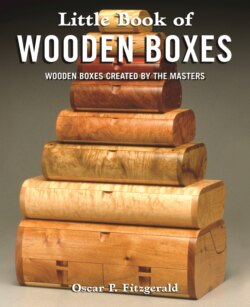Читать книгу Little Book of Wooden Boxes - Oscar Penn Fitzgerald - Страница 12
Personal Boxes
ОглавлениеIn addition to gift boxes, a number of other specialized containers were popular in the eighteenth and nineteenth centuries. Gentlemen carried nutmeg and graters to flavor their custard, and had pillboxes in their pockets. Different boxes held breath mints and candy, often in elegant boot-shaped boxes and other forms. Comfit boxes filled with candied fruit or seeds were also popular during the nineteenth century.
Women carried round, oval or heart-shaped patch boxes to store swatches of silk or taffeta that they applied to their faces to hide the ravages of smallpox and other blemishes. Fancy boxes of silver, gold, ivory, or enamel were often fitted with a gum-pot and brush to stick the fabric patch to the cheek. Other boxes, similar to women’s compacts today, held mirrors, rouge, and kohl for the eyes.
Among the ubiquitous containers are jewelry boxes, usually fitted with satin or velvet and divided into compartments to hold expensive body adornments.
This early nineteenth century, curly maple, schoolgirl box was probably made at the Bath, Maine, Female Academy. It is painted with romantic, ancient Greek and Roman scenes, including the eruption of Mount Vesuvius in 79 C.E.
By the mid-eighteenth century, trinket boxes to hold less-expensive items became popular. Trinkets were essentially small ornaments including jewelry, but also chains, beads, buckles, ribbons, and pendants. The women at female academies that sprung up around the United States in the early nineteenth century decorated many of these square or octagonal boxes. Trinket boxes and jewelry boxes continue in popularity to this day.
